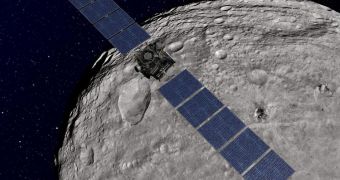According to officials at the NASA Jet Propulsion Laboratory (JPL), in Pasadena, California, the Dawn spacecraft has finally entered its fourth and final orbit around the giant asteroid Vesta. Its current path is called the low-altitude mapping orbit (LAMO).
This orbit takes it at an average altitude of about 130 miles (210 kilometers) above the protoplanet's surface, which is significantly closer than the International Space Station (ISS) is in respect to Earth.
The move marks the beginning of a new phase in the orbiter's science mission, which is scheduled to conclude in July 2015. Vesta is not Dawn's only target, NASA says. The probe also needs to visit the dwarf planet Ceres.
Like the giant asteroid, Ceres is also located inside our solar system's Inner Asteroid Belt (IAB). It will represent Dawn's primary science objective starting in 2015. If successful, this spacecraft will be the first to visit either of the two bodies.
Dawn is planned to study Vesta between July 2011 and July 2012, and then spend the next two and a half years traveling through the IAB, all the way to Ceres. It is scheduled to operate at the dwarf planet between February and July 2015.
Until that happens, the vehicle is now focused on studying the largest asteroid in the solar system. Over the past six months, it occupied three different orbits, with LAMO being the fourth and final one.
“Dawn has performed some complicated and beautiful choreography in order to reach this lowest orbit. We are in an excellent position to learn much more about the secrets of Vesta's surface and interior,” says JPL mission manager and Dawn chief engineer, Marc Rayman.
One of the most important aspects of the new orbit is that it will allow the spacecraft to measure the asteroid's gravitational field in close detail. This is very important for confirming the object's status as a protoplanetary body.
This, in turn, would be especially useful, since protoplanets are objects that should have become fully-fledged planets in the earliest days of the solar system. However, for some reason, they did not develop to their full potential.
Analyzing why this happened may be a good way for researchers to figure out what happened during those first few millions of years after the Sun first appeared. Dawn will gather data on these aspects, and more, for at least 10 weeks, while in LAMO.
“Dawn's visit to Vesta has been eye-opening so far, showing us troughs and peaks that telescopes only hinted at. It whets the appetite for a day when human explorers can see the wonders of asteroids for themselves,” Christopher Russell explains.
The expert, who is the principal investigator of the Dawn mission, holds an appointment as a space scientist at the University of California in Los Angeles (UCLA).

 14 DAY TRIAL //
14 DAY TRIAL //